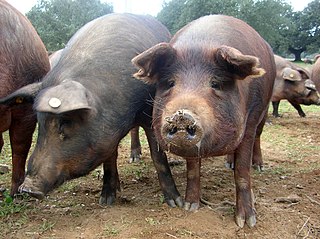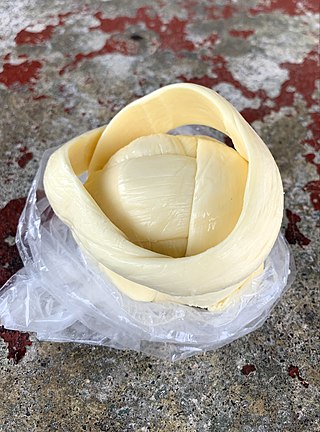
Club Sport Cartaginés Deportiva S.A., also known as Cartaginés, is a Costa Rican football club, that currently plays in the Liga de Fútbol de Primera División, the top division of Costa Rican football league system. Cartaginés' home venue is Estadio Jose Rafael Fello Meza, located in Barrio Asis of Cartago.

Oaxaca cheese, also known as quesillo and queso de hebra, is a white, semihard, low-fat cheese that originated in Mexico. It is similar to unaged Monterey Jack, but with a texture similar to mozzarella or string cheese.
Venezuelan cuisine is influenced by its European, West African, and indigenous traditions. Venezuelan cuisine varies greatly from one region to another. Food staples include corn, rice, plantains, yams, beans and several meats.

Turrialba Volcano is an active volcano in central Costa Rica that has been explosively eruptive in recent years including 2016 and in January, March and April 2017. Visitors used to be able to hike down into the main crater, but increased volcanic activity in 2014–17, resulting in large clouds of volcanic ash, led to the closure of the surrounding Turrialba Volcano National Park. However, with the eruptions subsiding, the park and access to the volcano reopened on December 4, 2020.
Canarian cuisine refers to the typical dishes and ingredients in the cuisine of the Canary Islands, and it constitutes an important element in the culture of its inhabitants. Its main features are the freshness, variety, simplicity, and richness of its ingredients, the mix of seafood and meat dishes, its cultural influences and the low knowledge of it by the rest of the world. Canarian cuisine is influenced by other cultures, especially that of the aboriginal inhabitants of the islands (Guanches), and has influenced Latin American cuisine.

Aguachica, is a city and municipality in the southern region of the Cesar Department, Colombia. There is no historical support on the date of its foundation; however, August 16, 1748 has been chosen by the community. Saint Roch is the patron saint of the municipality and August 16 is the date on which the Catholic Church celebrates its festival.

Pamplona is a municipality and city in Norte de Santander, Colombia. It is the fifth most populated city and the sixth most populated municipality in the department.
Turrialba is a canton in the Cartago province of Costa Rica. The head city is in Turrialba district.

Extremadura, Spain is known for its different ways of preparing the Iberian pork and mutton. The main characteristics of the traditional Extremaduran cuisine are its simplicity, its lack of clutter and its low cost. It is also a cuisine reflecting a generous spirit, for many of its preparations used to be cooked in large pots to share with visitors, friends, and neighbors. The resulting dishes are eaten with local bread.

Cheeses in Mexico have a history that begins with the Spanish conquest, as dairy products were unknown in pre-Columbian Mesoamerica. The Spanish brought dairy animals, such as cattle, sheep, and goats, as well as cheesemaking techniques. Over the colonial period, cheesemaking was modified to suit the mixed European and indigenous tastes of the inhabitants of New Spain, varying by region. This blending and variations have given rise to a number of varieties of Mexican cheeses. These are most popular in the country, although European cheeses are made, as well. Almost all cheese in Mexico is made with cows’ milk, with some made from goats’ milk. More recently, efforts have been made to promote sheep's milk cheeses. Most cheeses are made with raw (unpasteurized) milk. Cheeses are made in the home, on small farms or ranches, and by major dairy product firms. Between 20 and 40 different varieties of cheese are made in Mexico, depending on how one classifies them. Some, such as Oaxaca and panela, are made all over Mexico, but many are regional cheeses known only in certain sections on the country. Some of the least common are in danger of extinction.

Pejibaye is a district of the Jiménez canton, in the Cartago province of Costa Rica.
Turrialba is a district of the Turrialba canton, in the Cartago province of Costa Rica.

Paipa cheese is a semi-hard, semi-fat, and semi-aged cheese produced solely in the Valley of Sogamoso, which includes the towns of Paipa and Sotaquirá, due to its protected denomination of origin status granted by the Colombian government.
Santa Cruz is a district of the Turrialba canton, in the Cartago province of Costa Rica.

Víctor Iván Vargas Blanco is Costa Rican plasma and nuclear fusion physicist. He is renowned for his work in plasma physics and nuclear fusion. Currently, as a professor and tenured researcher at the Costa Rica Institute of Technology, he heads the Plasma Laboratory for Fusion Energy and Applications that he founded in 2011.

Payoyo cheese is a type of cheese made from the milk of Payoya goats and Merina grazalemeña sheep in Villaluenga del Rosario and other areas of the Sierra de Grazalema, Spain. It began production in 1997 and has become a staple of Spanish delicatessen. The term payoyo is the demonym for Villaluenga del Rosario.

Pago de La Jaraba is a Spanish winery in Castilla–La Mancha, Spain. The winery uses the Vino de Pago wine appellation, a classification for Spanish wine applied to individual vineyards or wine estates, unlike the Denominación de Origen Protegida (DOP) or Denominación de Origen Calificada (DOCa) which is applied to an entire wine region. The Pago de La Jaraba winery was formed as a Vino de Pago in 2019, and geographically it lies within the extent of the La Mancha DOP. The winery also produces artisan Manchego cheese under the D.O.P. queso manchego appellation. Queso baja calidad

The United Mexican States have 18 Designations of Origin, granted by the Mexican Institute of Industrial Property (IMPI), which also issues declarations to protect the product, register the brand and authorize its use. However, these names are not created by the IMPI, but rather "exist because of factual situations; that is, they are first used, famous and recognized by the public that consumes them, and later, they are protected through the corresponding declaration".

Palmito cheese is a popular fresh cheese from Costa Rica that resembles a knotted ball of string cheese. It has been described as light, salty, and stringy with a texture comparable to mozzarella cheese. It is similar to Oaxaca cheese in Mexico. It is a type of stretched-curd cheese made by using the pasta filata technique. It is thought that the technology to produce the cheese came from Italian immigrants. At an expo in Zarcero in 2007, a 132 kg ball of palmito cheese was created by local cheesemakers.














